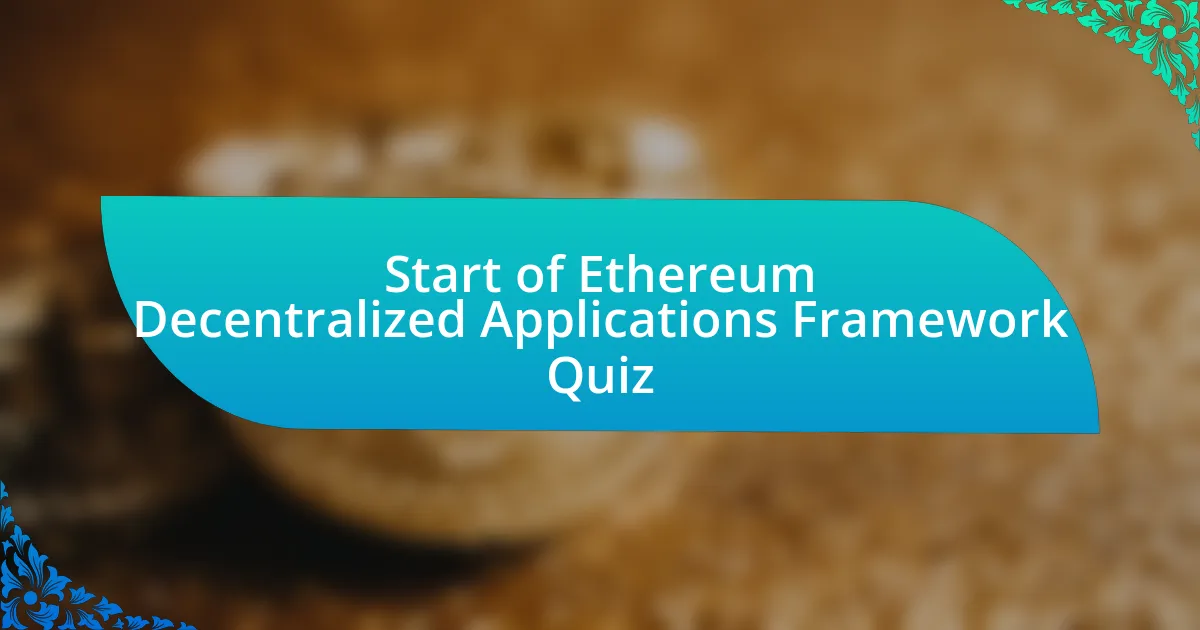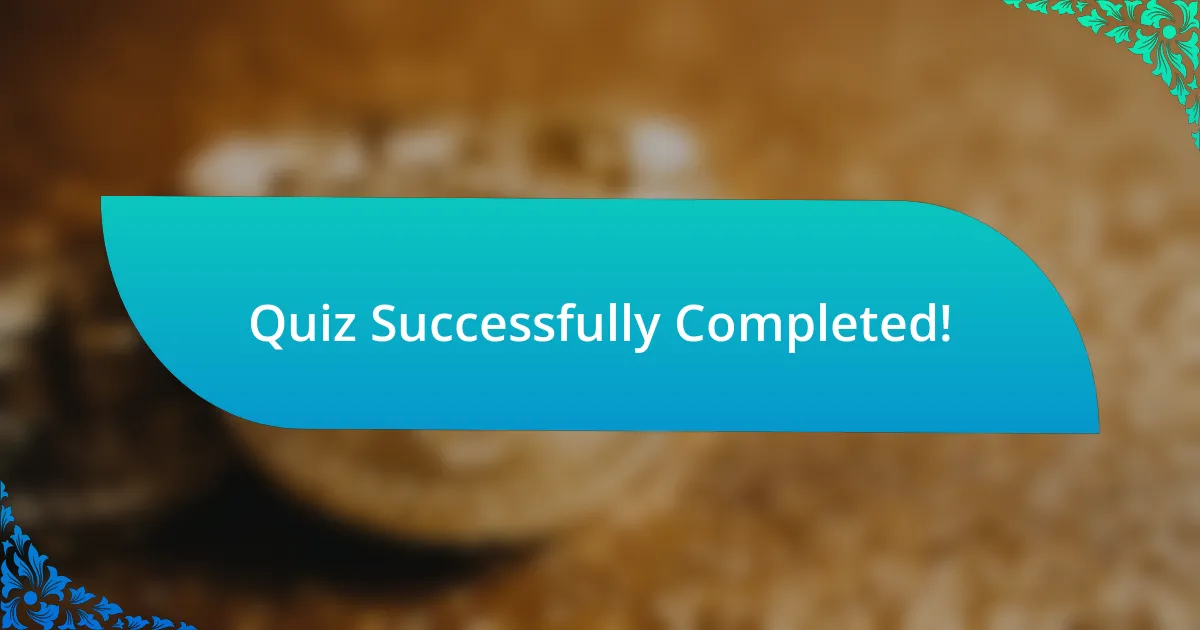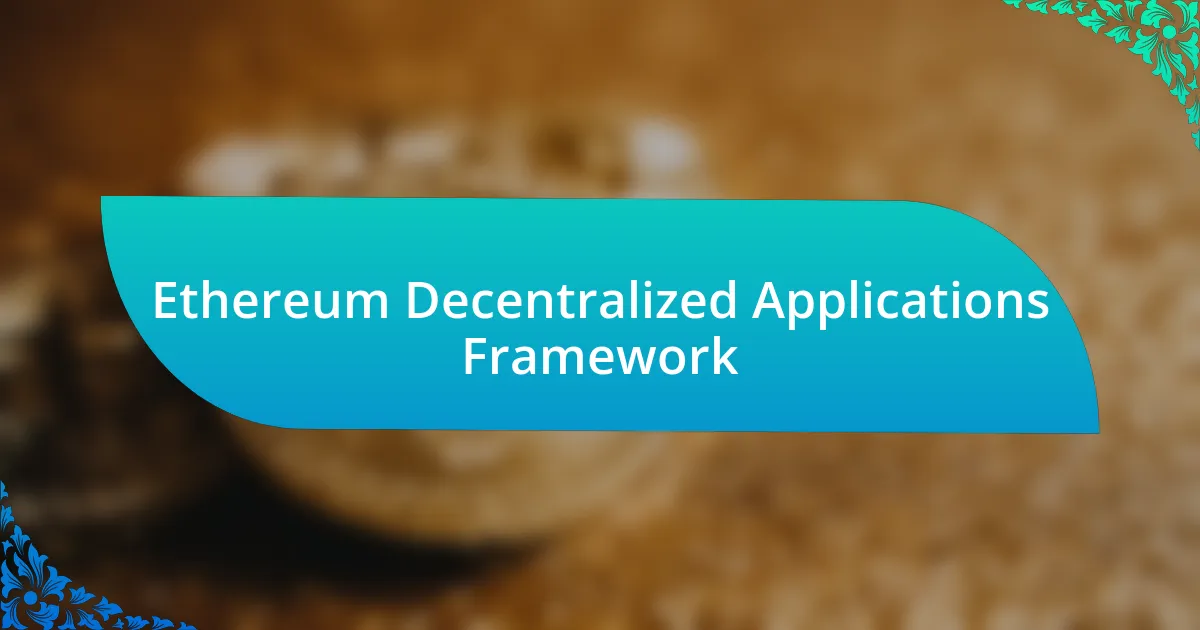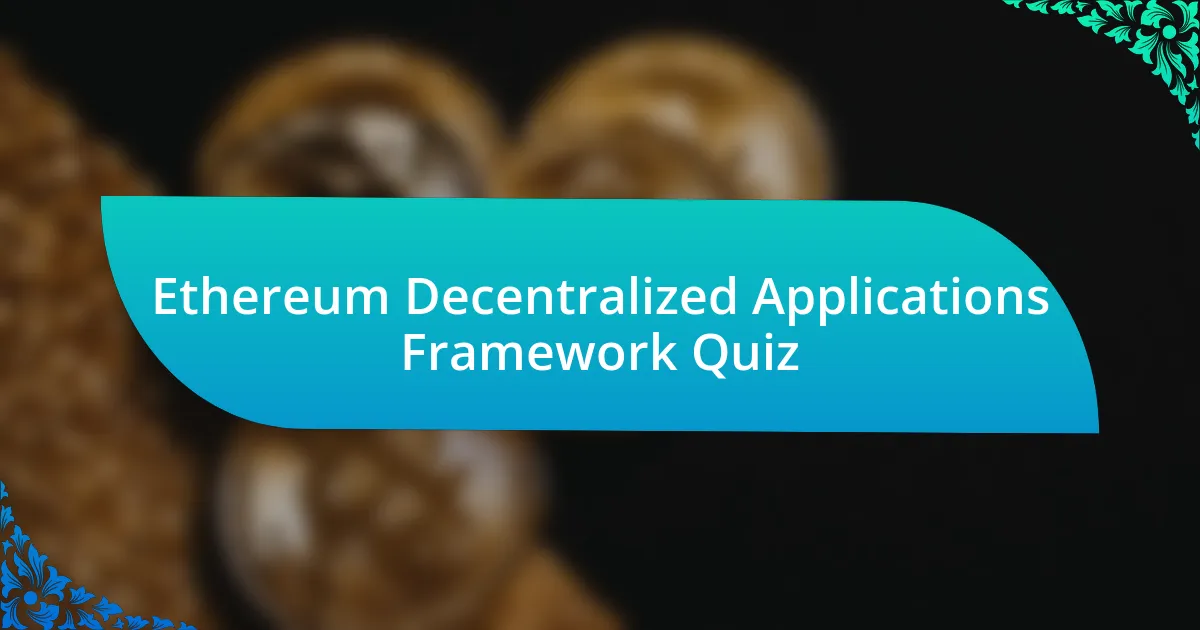
Start of Ethereum Decentralized Applications Framework Quiz
1. What is Ethereum primarily known for?
- Mining Bitcoin
- Creating decentralized applications (dApps)
- Sending email messages
- Storing digital files
2. Who is credited as one of the main creators of Ethereum?
- Charlie Lee
- Satoshi Nakamoto
- Vitalik Buterin
- Brian Armstrong
3. What does EVM stand for in the Ethereum context?
- Ethereum Virtual Machine
- Ethereum Verification Method
- Ethereum Value Model
- Ethereum Variable Mechanism
4. Which programming language is primarily used for smart contracts on Ethereum?
- Solidity
- Python
- C++
- Java
5. How do smart contracts operate on the Ethereum blockchain?
- Smart contracts are stored offline and require internet access to execute.
- Smart contracts are only operational on private blockchains.
- Smart contracts execute code autonomously on the Ethereum blockchain.
- Smart contracts require manual approval for every transaction.
6. Define a decentralized application (dApp).
- A decentralized application (dApp) is an application built on a decentralized network that combines a smart contract and a frontend user interface.
- A decentralized application (dApp) is an app that only works offline without any network capability.
- A centralized application (cApp) is a conventional app managed by a single entity with no connection to a blockchain.
- A decentralized application (dApp) is a fully automated program that does not require any user interface or interaction.
7. What are the main characteristics of dApps?
- Decentralized, simplified, time-consuming, and risky.
- Decentralized, deterministic, Turing complete, and isolated.
- Centralized, deterministic, user-friendly, and slow.
- Centralized, random, Turing incomplete, and inefficient.
8. On what type of ledger are Ethereum transactions recorded?
- Data warehouse
- Blockchain
- Centralized database
- File system
9. What cryptocurrencies serve as the value token on Ethereum?
- Ripple (XRP)
- Litecoin (LTC)
- Ether (ETH)
- Bitcoin (BTC)
10. How does Ethereum`s blockchain differ from Bitcoin`s blockchain?
- Ethereum has a fixed supply of coins like Bitcoin.
- Bitcoin transactions are recorded in private ledgers.
- Bitcoin allows for faster transaction speeds than Ethereum.
- Ethereum supports smart contracts, while Bitcoin does not.
11. What is the main function of the EVM?
- The EVM stores user data in a centralized server.
- The EVM executes smart contracts in a virtual environment.
- The EVM creates new cryptocurrencies each month.
- The EVM verifies transactions using physical documentation.
12. What does Gas represent in the Ethereum ecosystem?
- Gas is an internal pricing mechanism for executing smart contracts.
- Gas is a programming language for smart contracts.
- Gas refers to the amount of storage on the blockchain.
- Gas is a cryptocurrency used for trading.
13. Describe Truffle Suite`s role in Ethereum development.
- Truffle Suite is a cryptocurrency wallet for storing Ether securely.
- Truffle Suite is an online marketplace for buying and selling decentralized applications.
- Truffle Suite is a set of tools that assist developers in building and managing smart contracts.
- Truffle Suite is a blockchain itself for trading cryptocurrencies.
14. How does Hardhat support developers in creating dApps?
- Hardhat automates user interaction in dApps.
- Hardhat is primarily used for creating mobile applications.
- Hardhat helps with building, testing, debugging, and deploying dApps seamlessly.
- Hardhat only focuses on providing a storage solution for dApps.
15. What functionality does Remix provide to developers?
- Remix is a web-based IDE for Ethereum smart contract development and deployment.
- Remix is a hardware wallet for storing Ether securely.
- Remix is a mining software used to earn Ether.
- Remix is a programming language specifically for dApp development.
16. What is the purpose of the Doors component in the DAPP framework?
- The Doors component enables users to access and interact with web3.
- The Doors component handles offline storage for user data.
- The Doors component provides security for the operating system.
- The Doors component manages database connections for back-end services.
17. What does the Applications component in the DAPP framework do?
- The Applications component secures smart contracts with encryption techniques.
- The Applications component manages the transaction fees on the blockchain.
- The Applications component stores user data in a centralized database.
- The Applications component connects users with protocols and primitives via a user interface and experience.
18. In the context of dApps, what does the Primitives component provide?
- Comprehensive user management tools
- Centralized data storage solutions
- Task-specific, interoperable building blocks
- High-level programming languages
19. What foundational purpose does the Protocols component serve in the DAPP framework?
- The Protocols component manages data storage and retrieval.
- The Protocols component constructs the foundational blockchain architecture of web3.
- The Protocols component is responsible for designing user interfaces.
- The Protocols component creates non-fungible tokens (NFTs).
20. Name some critical tools necessary for developing dApps.
- Truffle Suite
- GitHub Repo
- Azure Cloud
- Visual Studio
21. How does Truffle Suite facilitate automated testing in Ethereum?
- Truffle Suite generates cryptocurrency wallets for users.
- Truffle Suite allows developers to trade Ethereum assets directly.
- Truffle Suite facilitates manual audits of smart contracts.
- Truffle Suite provides automated testing frameworks for smart contracts.
22. What features make Hardhat a useful development tool for Ethereum?
- Hardhat is designed exclusively for building mobile applications.
- Hardhat automates the compilation of JavaScript code for web browsers.
- Hardhat generates static HTML files for dApp deployment.
- Hardhat provides a debugging environment for Solidity and a plugin ecosystem.
23. Explain the significance of Solidity in the development of Ethereum applications.
- Solidity is the primary programming language for creating and deploying smart contracts efficiently.
- Solidity is the main database technology used for storing user data.
- Solidity is a marketing tool for promoting Ethereum-based projects.
- Solidity is a protocol for securing Ethereum wallets and transactions.
24. Why is a user-friendly interface important in dApp development?
- A basic UI streamlines the coding process for developers.
- An intuitive UI enhances user experience and guides interactions.
- A flashy UI distracts users from the main functionality.
- A complex UI encourages user engagement and exploration.
25. Identify common real-world applications for smart contracts.
- Video streaming
- Social media networking
- Email services
- Real estate transactions
26. Describe the differences between private and public networks in Ethereum.
- A private network ensures data privacy and permissions, while a public network is open and transparent.
- A private network only supports cryptocurrency, while a public network can host different digital assets.
- A private network allows unlimited users, while a public network has restricted access.
- A private network is always slower than a public network due to security measures.
27. What is MetaMask and its use case in Ethereum?
- MetaMask is a hardware wallet for storing Bitcoin offline.
- MetaMask is a framework for developing smart contracts.
- MetaMask is a popular browser-based Ethereum wallet that allows users to interact with dApps on the Ethereum network.
- MetaMask is a trading platform for cryptocurrency exchanges.
28. Can transactions on the Ethereum network be confidential?
- Yes, transactions can be made confidential using privacy protocols.
- Yes, but only if the users pay extra fees.
- No, all transactions are always public and visible.
- No, transactions can only be anonymous on Bitcoin.
29. What is the purpose of a Testnet in Ethereum development?
- Testnet is where all transactions are stored permanently.
- Testnet is a social networking platform for developers.
- Testnet is used to mine virtual currencies for profit.
- Testnet allows developers to test their smart contracts without using real Ether.
30. Is real Ether required for testing dApps on Ethereum?
- No, test networks do not function without real Ether.
- Yes, real Ether is essential for all tests.
- Yes, only real Ether can simulate mainnet conditions.
- No, free Ether can be used in test networks.

Quiz Successfully Completed!
Congratulations on completing the quiz on the Ethereum Decentralized Applications Framework! Engaging with this material has likely deepened your understanding of how decentralized applications operate on the Ethereum platform. You’ve explored essential concepts, from smart contracts to the importance of trustlessness in the blockchain environment. Each question challenged your knowledge and expanded your perspective on decentralized technology.
Through this quiz, you may have learned about the key components that make Ethereum a leading choice for developers. Understanding the ecosystem’s structure can empower you to appreciate the innovative applications being built on it. You’ve taken a significant step in grasping the technical intricacies that underpin decentralized applications and the benefits they offer to users worldwide.
We invite you to explore the next section on this page, where you can dive even deeper into the Ethereum Decentralized Applications Framework. This additional information will enhance your knowledge and provide context for what you’ve learned. Engaging with these resources will equip you with the tools needed to navigate the evolving world of blockchain technology confidently.

Ethereum Decentralized Applications Framework
Overview of Ethereum and Its Blockchain Technology
Ethereum is a decentralized blockchain platform that enables developers to build and deploy smart contracts and decentralized applications (dApps). It operates on a global network of nodes, ensuring transparency and security. By using blockchain technology, Ethereum allows for trustless transactions and data storage. This framework decentralizes control, minimizing reliance on centralized authorities. Its innovation lies in the use of the Ethereum Virtual Machine (EVM), which executes scripts using an international network of public nodes.
Decentralized Applications (dApps) Explained
Decentralized Applications (dApps) are software applications that run on a peer-to-peer network, rather than on centralized servers. They leverage smart contracts on the Ethereum blockchain to provide functionality without needing intermediaries. dApps can serve various purposes such as finance, gaming, and social networking. Their open-source nature encourages collaboration and allows users to verify code and data. The decentralized characteristic enhances user control and reduces censorship.
Smart Contracts and Their Role in Ethereum Framework
Smart contracts are self-executing contracts with the terms of the agreement directly written into code. They eliminate the need for intermediaries by automating processes and ensuring compliance. On Ethereum, smart contracts enable developers to create dApps with customizable rules and conditions. These contracts execute automatically when predefined conditions are met, reducing the likelihood of fraud. This functionality is key to Ethereum’s decentralized nature and usability.
Development Tools and Libraries for Ethereum dApps
Several tools and libraries streamline the development of Ethereum dApps. Popular frameworks include Truffle, Hardhat, and Remix. Truffle offers a suite for managing smart contracts, while Hardhat focuses on debugging and testing. Libraries like Web3.js and ethers.js facilitate interaction between dApps and the Ethereum blockchain. These tools enhance productivity and help developers implement best practices in smart contract development.
Challenges and Considerations in Building Ethereum dApps
Building dApps on Ethereum comes with various challenges. Scalability remains a primary concern, as Ethereum can experience congestion during peak usage. High gas fees can affect transaction costs, making it less attractive for some users. Security vulnerabilities are another consideration, as poorly coded smart contracts can lead to exploits. Developers must also navigate regulatory challenges in different jurisdictions. These factors necessitate thorough planning and testing for successful deployment.
What is the Ethereum Decentralized Applications Framework?
The Ethereum Decentralized Applications (dApps) Framework refers to the set of tools and technologies that allow developers to build decentralized applications on the Ethereum blockchain. This framework utilizes smart contracts, which are self-executing contracts with the terms of the agreement directly written into code. Ethereum’s platform enables these applications to operate without a central authority, ensuring security and transparency. As of October 2023, thousands of dApps, ranging from finance to gaming, leverage this framework.
How do developers create applications using the Ethereum Decentralized Applications Framework?
Developers create applications using the Ethereum Decentralized Applications Framework by writing smart contracts in programming languages such as Solidity or Vyper. They then deploy these contracts on the Ethereum blockchain using Ethereum clients like Geth or Parity. The process involves testing the contracts in development environments like Remix or Truffle, followed by deploying them to the Ethereum mainnet. Essentially, this enables the applications to interact with the blockchain directly.
Where can one find decentralized applications built on Ethereum?
Decentralized applications built on Ethereum can be found on various platforms and marketplaces. Notable platforms include decentralized application directories like State of the DApps, DappRadar, and DeFi Pulse. These sites categorize dApps by their functionality, providing access to numerous applications ranging from financial services to games, making it easy for users to discover and interact with them.
When was the Ethereum Decentralized Applications Framework launched?
The Ethereum Decentralized Applications Framework was launched alongside the Ethereum network on July 30, 2015. Ethereum introduced smart contracts as a core feature, enabling developers to create decentralized applications that leverage blockchain technology for various uses. This launch marked a significant shift in how applications could be built and operated autonomously online.
Who are the main contributors to the Ethereum Decentralized Applications Framework?
The main contributors to the Ethereum Decentralized Applications Framework include Vitalik Buterin, the co-founder of Ethereum, and a team of developers known collectively as the Ethereum Foundation. Additionally, numerous independent developers and organizations contribute to its ecosystem, creating tools, libraries, and dApps. This collaborative effort has fueled the rapid growth and evolution of Ethereum-based technologies.

